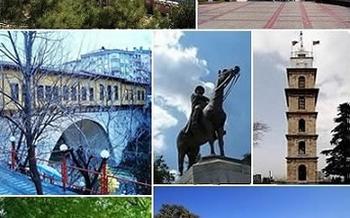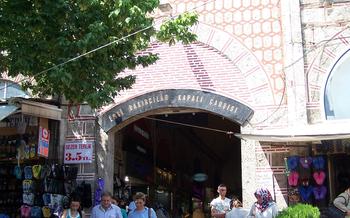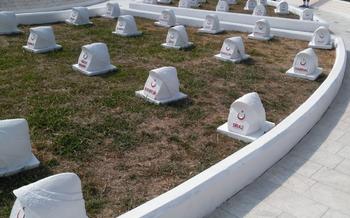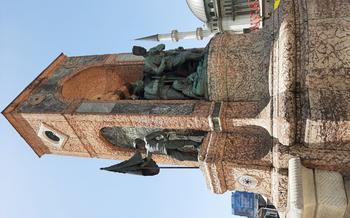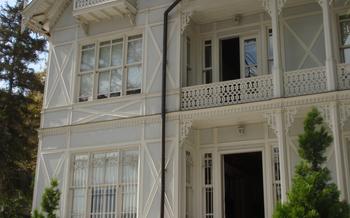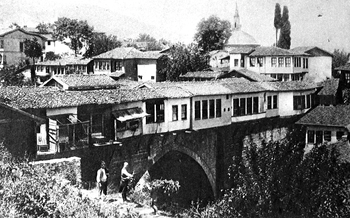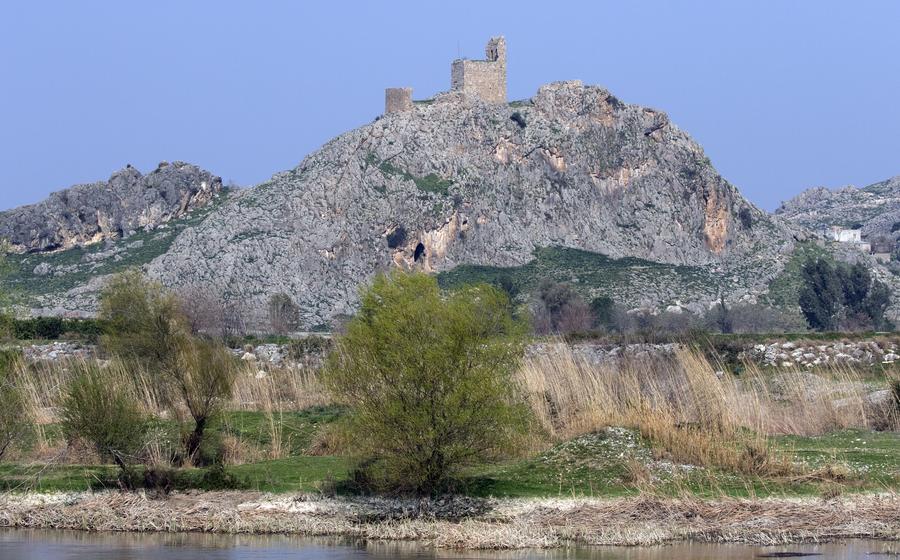
Osmaniye Central Bath House (Hamam)
- Osmaniye Central Bath House: A Historical Gem
- Location and Getting There
- Opening Hours and Prices
- Benefits of a Traditional Bath
- Preparation for Your Visit
- Cultural Insights and Traditions
- Respecting Local Customs
- Exploring Osmaniye After Your Bath
- Other Notable Bath Houses in Turkey
- Preserving the Bath House Culture: A Delicate Balance
- Fun Facts and Trivia
- Photography Tips for Your Visit
- Insider Tip: Local Secret
Osmaniye Central Bath House: A Historical Gem
The Osmaniye Central Bath House, nestled in the heart of the city, is a true architectural gem that has stood witness to centuries of history. Built during the Ottoman era, it's a testament to the rich cultural heritage of Turkey. Its impressive facade, adorned with intricate carvings and vibrant tiles, hints at the grandeur that awaits within.
Step inside this historic establishment, and you'll be transported back in time. The bath house's layout reflects the traditional Turkish bathing ritual, with separate sections for men and women. The air is filled with the soothing sounds of flowing water and the gentle hum of conversation, creating a serene atmosphere that invites relaxation and rejuvenation.
Location and Getting There
The Osmaniye Central Bath House is conveniently located in the heart of the city, making it easily accessible from any part of Osmaniye. The exact address is Atatürk Bulvarı Özer İş Merkezi Kat: 1 No: 22, 80010 Merkez/Osmaniye. Whether you prefer public transportation or driving your own car, reaching the bath house is a breeze.
If you're using public transport, hop on the local bus that stops right in front of the bath house. The bus stop is called "Hamam Önü" and is well-connected to different parts of the city. Alternatively, you can take a taxi, which is a reliable and affordable option in Osmaniye.
For those who prefer driving, there's ample parking space available in the vicinity of the bath house. The streets around the bath house offer designated parking spots, so you can easily find a spot to leave your car while you indulge in a rejuvenating bathing experience.
To make your visit even more convenient, the Osmaniye Central Bath House is within walking distance from other notable attractions in the city. After your relaxing bath, you can explore the historic sites, museums, and vibrant markets nearby. Stroll through the charming streets and soak in the local ambiance, making your visit to Osmaniye a truly memorable one.
Opening Hours and Prices
The Osmaniye Central Bath House is open to the public every day of the week, except for Mondays. Its operating hours are from 10 am to 10 pm, providing ample time for visitors to enjoy the bathing experience.
Ticket prices vary depending on whether you are a local resident or a tourist. For locals, the entrance fee is a mere 10 Turkish Lira, while tourists are charged 20 Turkish Lira. The bath house also offers discounted rates for students and groups, making it an affordable option for all.
It's worth noting that the bath house does not offer any additional services such as massages or body scrubs, so the entrance fee covers only the use of the facilities. To avoid crowds and ensure a more relaxed experience, it's advisable to visit the bath house during the weekdays, as weekends tend to be busier.
Benefits of a Traditional Bath
A visit to a traditional Turkish bathhouse, or hamam, offers a plethora of benefits that extend beyond mere physical cleansing. It is an immersive cultural experience that rejuvenates both body and soul. The warm, humid environment relaxes tense muscles, promotes circulation, and relieves stress, leaving you feeling refreshed and invigorated. The traditional bathing ritual, which involves alternating between hot and cold rooms, stimulates the immune system and improves overall well-being.
Beyond its physical benefits, the Turkish bathhouse holds deep cultural significance. It is a place where people come together to socialize, relax, and connect with their community. The shared experience of bathing fosters a sense of camaraderie and belonging. Historically, bathhouses have played a crucial role in Turkish society, serving as centers for social gatherings, religious rituals, and even matchmaking.
My personal experience at the Osmaniye Central Bath House was transformative. The soothing heat of the steam room melted away my worries, while the cold plunge pool invigorated my senses. As I lay on the heated marble slab, receiving a traditional kese scrub, I felt my skin shedding layers of stress and fatigue. The massage that followed was the perfect finishing touch, leaving me feeling relaxed and rejuvenated. The entire experience was a testament to the enduring power of this ancient bathing tradition.
Preparation for Your Visit
Visiting a traditional bath house requires a certain level of preparation to ensure a comfortable and respectful experience. Here's what you need to know before stepping into the Osmaniye Central Bath House:
- What to bring:
- Swimsuit or bathing suit.
- Towel (although some bath houses provide rentals).
- Soap or body wash.
- Shampoo and conditioner (optional).
- Flip-flops or slippers.
-
A small amount of cash for tips and any additional services.
-
Proper attire:
- While inside the bath house, it is customary to wear a peshtemal, a traditional Turkish towel that wraps around the body.
- You can purchase one at the bath house or bring your own.
-
Avoid wearing revealing or tight clothing.
-
Etiquette for men and women:
- The bath house is typically divided into separate sections for men and women, ensuring privacy.
-
Men and women bathe separately, so it's important to respect the designated areas.
-
Health considerations:
- If you have any health conditions, such as heart problems or high blood pressure, it's advisable to consult with a doctor before visiting the bath house.
- The high temperatures and humidity can be overwhelming for some individuals.
- Stay hydrated by drinking plenty of water throughout your visit.
Cultural Insights and Traditions
Bath houses in Turkey are not just about cleansing the body but also hold deep cultural significance. One of the key elements is the peshtemal, a traditional Turkish towel used in bath houses. It is made from lightweight cotton or linen and is designed to absorb water quickly while providing modesty. The peshtemal is not only a practical item but also a symbol of Turkish culture and tradition.
Bath houses in Turkey are also social gathering places, where people from all walks of life come together to relax and socialize. It is a place where conversations flow, friendships are forged, and cultural exchange takes place. The atmosphere is usually warm and welcoming, and visitors often leave feeling refreshed and rejuvenated, both physically and socially.
I personally witnessed this social aspect during my visit to the Osmaniye Central Bath House. I was struck by the friendly interactions between the bath attendants and the customers, as well as among the customers themselves. People were sharing stories, laughing, and enjoying each other's company. It was a heartwarming experience that showcased the true spirit of Turkish hospitality.
Respecting Local Customs
When visiting the Osmaniye Central Bath House, it's important to be respectful of local customs and traditions. Here are some guidelines to keep in mind:
-
Modesty and Appropriate Behavior: The bath house is a place of relaxation and tranquility, so it's essential to maintain modesty and appropriate behavior. Avoid loud noises, disruptive actions, or any behavior that might disturb other bathers.
-
Maintaining Silence: The bath house is a place for relaxation and reflection, so it's customary to maintain silence or speak in hushed tones. This allows everyone to enjoy the peaceful atmosphere and fully immerse themselves in the bathing experience.
-
Tipping Etiquette: It's customary to tip the staff at the bath house for their services. The amount you tip is up to your discretion, but a small token of appreciation is always welcomed.
-
Seeking Permission before Taking Photos: Before taking any photos inside the bath house, it's important to seek permission from the staff and other bathers. This is to ensure that everyone's privacy is respected and that the peaceful atmosphere is maintained.
Exploring Osmaniye After Your Bath
Once you've rejuvenated in the Osmaniye Central Bath House, the city of Osmaniye beckons you to explore its many treasures. Just a stone's throw away from the bath house, you'll find the majestic Osmaniye Castle, a testament to the city's rich history. Perched atop a hill, the castle offers breathtaking panoramic views of the city and the surrounding countryside.
For a taste of local cuisine, head to one of the many restaurants in the city center. Indulge in traditional Turkish dishes such as kebabs, pide (Turkish pizza), or künefe (shredded wheat dessert). Don't miss the chance to try Osmaniye's famous dish, "cevizli sucuk," a sweet sausage made with walnuts.
If you're looking for souvenirs, the local markets are a great place to find traditional Turkish handicrafts, carpets, and jewelry. For a truly unique experience, visit the Osmaniye Bazaar, held every Saturday, where you can find everything from fresh produce to handmade goods.
My personal recommendation for a post-bath experience is to take a leisurely stroll along the Ceyhan River, which flows through the city. The serene atmosphere and picturesque views are the perfect way to unwind after your refreshing bath.
Other Notable Bath Houses in Turkey
The Osmaniye Central Bath House is not the only historical bath house in Turkey. Other cities boast equally impressive and well-preserved bath houses that offer a similar experience.
In Istanbul, the Çemberlitaş Hamamı is a must-visit. Built in the 16th century, it is one of the oldest and largest bath houses in the city. Its stunning architecture and intricate tilework make it a popular destination for both locals and tourists.
Another notable bath house is the Kurşunlu Hamamı in Ankara. Constructed in the 15th century, it is renowned for its unique lead-covered domes that give it its name. The bath house features a variety of rooms, including a hot room, a cold room, and a massage room, each offering a different bathing experience.
In Bursa, the Emir Sultan Hamamı is a hidden gem. Built in the 14th century, it is one of the oldest bath houses in Turkey and is still in operation today. Its serene atmosphere and traditional Turkish architecture make it a popular choice for those seeking a relaxing and authentic bathing experience.
Each of these bath houses has its own unique features and historical significance, offering visitors a glimpse into the rich bathing culture of Turkey. Whether you're in Osmaniye, Istanbul, Ankara, or Bursa, be sure to experience the rejuvenating and culturally enriching tradition of a traditional Turkish bath.
Preserving the Bath House Culture: A Delicate Balance
Traditional bath houses, like the Osmaniye Central Bath House, face numerous challenges in the modern era. Changing lifestyles, urbanization, and the rise of modern bathing facilities have led to a decline in their popularity. Preserving and promoting this cultural heritage requires concerted efforts from various stakeholders.
One crucial step is raising awareness about the historical and cultural significance of bath houses. Educating the younger generation about the benefits and traditions associated with these establishments can foster a sense of appreciation and encourage them to continue the practice.
Tourism plays a vital role in supporting bath houses. By promoting these unique experiences to visitors, we can generate revenue that helps maintain and restore these historical gems. Responsible tourism that respects local customs and traditions ensures the sustainability of these establishments while preserving their authenticity.
Additionally, government initiatives and regulations can provide financial support and incentives for the preservation of bath houses. By recognizing their cultural value and offering tax breaks or grants, authorities can encourage owners to maintain and renovate these historic structures.
Preserving the bath house culture is not merely about maintaining physical structures; it's about safeguarding a living tradition that has been an integral part of Turkish society for centuries. By embracing and supporting these establishments, we can ensure that future generations continue to experience the unique cultural and therapeutic benefits of traditional bath houses.
Fun Facts and Trivia
The Osmaniye Central Bath House is steeped in history and local lore. One intriguing legend tells of a secret tunnel that once connected the bath house to the nearby castle. It is said that this tunnel was used by the castle's residents to escape in times of danger.
Another unique tradition associated with the bath house is the "kese" ritual. This involves a vigorous body scrub using a rough mitt made from goat hair. The kese is believed to remove dead skin cells, improve circulation, and leave the skin feeling soft and smooth.
Over the years, the Osmaniye Central Bath House has welcomed many famous visitors, including Mustafa Kemal Atatürk, the founder of the Turkish Republic. Atatürk was a regular patron of the bath house and is said to have enjoyed relaxing in its hot and cold rooms.
During my visit, I had the opportunity to chat with a local who shared a funny anecdote. He told me about a time when a group of tourists accidentally wandered into the women's section of the bath house. The women were understandably surprised, but they all had a good laugh about it.
Photography Tips for Your Visit
To fully capture the essence of the Osmaniye Central Bath House through photography, it's important to consider a few key tips. Firstly, explore different angles to showcase the architectural beauty of the building, both inside and out. The intricate details of the domes, arches, and tilework deserve special attention.
Regarding lighting, natural light is always preferable. Try to visit during the daytime to make the most of the sunlight filtering through the stained-glass windows, creating a magical ambiance. Artificial lighting may introduce unwanted color casts, so adjust your camera settings accordingly.
Remember to respect the privacy of other bathers. While capturing the essence of the bath house is important, it's crucial to avoid taking photos of individuals without their consent. Ask permission before directing your lens towards anyone, and always be mindful of their comfort.
Finally, don't be afraid to experiment with different perspectives. Try shooting from low angles to emphasize the grandeur of the domes, or capture the reflections of the bath house in the water pools for a unique artistic effect. The Osmaniye Central Bath House offers a wealth of photographic opportunities, so let your creativity shine through.
Insider Tip: Local Secret
For an unforgettable experience, time your visit to coincide with the annual Osmaniye Bath Festival, held every summer. This vibrant celebration showcases the rich bathing traditions of the region, with colorful parades, traditional music and dance performances, and special events inside the bath house. Immerse yourself in the festive atmosphere, savor delicious local cuisine, and witness the unique rituals and customs that make this festival a must-attend event. It's a fantastic opportunity to connect with the local community and experience the vibrant culture of Osmaniye firsthand.
